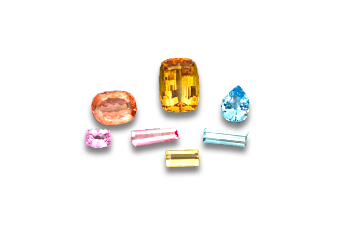TOPAZ
Topaz is an aluminum fluorosilicate that's found in many colors including yellow, orange, brown, pink, red, blue, light green and even colorless. Yellow shades are the most common. It's been a popular gem for over 2,000 years and was even dedicated to Jupiter by the Romans. It has been so sought after that the more common citrine has often been incorrectly presented as topaz. Any confusion is heightened by the fact that both topaz and citrine are birthstones for November. Topaz is a gem that can occur virtually free of internal features and forms in very large crystals. Gems weighing more than 2,000 carats (about 1 lb.) have been fashioned. In the Portuguese crown, the Braganza, there is a 1,680 carat topaz that is so beautiful; it was thought to be a diamond. Topaz, in general, is plentiful and can be found around the world. Its most common sources are Brazil and Nigeria but it's also found in Australia, Burma, Mexico, Namibia, Pakistan, Sri Lanka, the United States and Russia. The most desirable variety is called "Imperial." Its color is red, deep pink or reddish orange and is much harder to find.

Image Above: Some of these popular shades can be achieved through heating. With a combination of radiation and heat, varying degrees of blue can also be created. The hardness of topaz, 8 on the Moh's hardness scale, is quite high. However, its toughness is poor, due to one perfect cleavage direction, it's susceptible to thermal shock and its color may be altered by high heat. For these reasons the use of ultrasonic and steam cleaners is not advisable.

